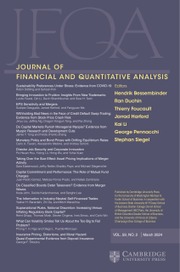No CrossRef data available.
Article contents
Optimal Portfolio Choice with Fat Tails and Parameter Uncertainty
Published online by Cambridge University Press: 11 August 2025
Abstract
Existing portfolio combination rules that optimize the out-of-sample performance under parameter uncertainty assume multivariate normally distributed returns. However, we show that this assumption is not innocuous because fat tails in returns lead to poorer out-of-sample performance of the sample mean–variance and sample global minimum-variance (GMV) portfolios relative to normality. Consequently, when returns are fat-tailed, portfolio combination rules should allocate less to the sample mean–variance and sample GMV portfolios, and more to the risk-free asset, than the normality assumption prescribes. Empirical evidence shows that accounting for fat tails in the construction of optimal portfolio combination rules significantly improves their out-of-sample performance.
Information
- Type
- Research Article
- Information
- Copyright
- © The Author(s), 2025. Published by Cambridge University Press on behalf of the Michael G. Foster School of Business, University of Washington
Footnotes
We are grateful to George G. Pennacchi (the editor), Konark Saxena (the referee), Xinghua Zheng, and Guofu Zhou for their valuable comments.

